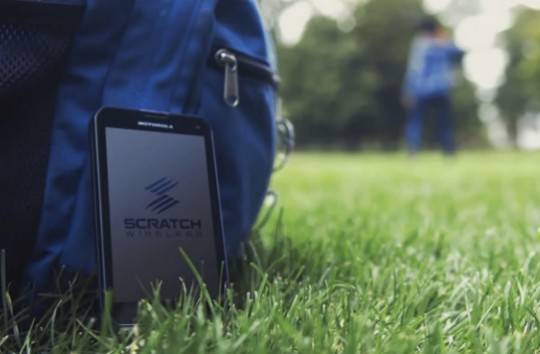
Scratch Wireless first arrived several months earlier when they announced plans to fight the other, “too expensive” cellular service options. They are an MVNO style carrier and will be going on the premise of using WiFi first. Well, while the service first launched as an invite-only offering, they have since shifted and are now open for any and all that wish to check it out.
Scratch Wireless goes on the concept that people are connected to WiFi networks roughly 80 percent of the time. To that point, the service offers free calling over WiFi. Of course, you can also use data as would normally would on any other WiFi device. One interesting aspect of the service is with text messaging — free over both WiFi and cellular.
For those times when you are not connected to WiFi and need to make a call or get online, Scratch Wireless does offer cellular passes. These make use of the Sprint cellular network and include options for data and voice. A 24-hour pass for either will set you back $1.99 and a 30-day pass is $14.99. The 24-hour pass includes 30 minutes of voice calling or 25MB of data. The 30-day pass ups those to 250 minutes and 200MBs respectively.
https://www.youtube.com/watch?v=pl3aCjVWbnk
To recap, calling is free on WiFi and data is free on WiFi. You can get a cellular pass for voice and/or data. And lastly, text messaging is free regardless of whether you are connected to a cellular of WiFi network. While this is all low enough in price so far, the catch comes in with buying the phone. Scratch Wireless users will be required to buy a compatible phone, which in this case means just one option.
The available phone is the slider-style Motorola Photon Q, which is priced at $269. Bottom line here, if you are good using the Photon Q and live in a world where you are almost always connected to WiFi, Scratch Wireless may be one to consider.
VIA: The Next Web










Only 250MB for a 30 day pass?
This is a focus on WiFi first, so they keep the monthly pass low by keeping allotments low and hoping you use WiFi
Interesting. I do not see how WiFi can be used effectively if the cell sites do not have WiFi connectivity, and even if they did, your range will be drastically short, far less than a cellphone.
In places with poor cell coverage, you still have a need for WiFi, and almost none are configured to use a carrier’s site, your WiFi will be useless, even connecting to a restaurant’s free service, you need a number that connects to the specified service, such as Google Voice, with a dial out number, and a voicemai number connected to your cellphone’s number, so you can retrieve G-Voicemail calls. I don’t see this being the ‘next big thing’. Too many holes in the topology, not enough connectivity with WiFi, and far too fragmented to be of use outside a metro area.
Nice thought on implementation, just NO infrastructure to make the idea fly.
This requires a complete change in network design, beginning with a multi-channel WiFi access point, distributed antenna systems, large bandwidth data handling, as well as having enough voice channels within the WiFi architecture to make it come together seamlessly.
If you load a WiFi channel down, you must begin to divide the limited resources in a manner that allows those channels to be accessed, used and allocated for different services, such as data, video, audio and general housekeeping data, like site configuration, spectrum management within the cell, overall health of the site, with this data being sent to HQ so the operators know if there are upcoming issues they need to deal with, such as failure of a radio channel, lightning damage, power outage, loss of signals, poor coverage and/or no coverage.
Next, how will each site handle hand-offs when on WiFi?
No sites I am aware of, have this capability, this would need to be a programming add-in, and the support logic designed to recognize specific low-level signals, and losses to hand off a WiFi call to a site with better RSSI levels from the uplinked mobile. Signals from the main site are rarely the issue, it is from the mobile side of the service, that has problems.
Losses must be overcome, from dense foliage, to structures, hills and valleys in the path of the signals, Fresnel zones, shadowing. A lot to deal with when designing a proper site, not to mention the added difficulties you will have when you include WiFi into the mix.
Now, if they took the satellite downlink approach, I can see fewer troubles, not including those that are well known already. You have a clearer path when looking down, but you also need a larger footprint to cover your targeted areas, a spot beam will no longer suffice here, you are not targeting a single location, but a larger section of a geographic territory.
Groove IP and Google voice are paid and free apps, You have a number assigned as your dial-out number, and a voicemail number that is linked to your cellphone for incoming calls(routed to voicemail only). This is what Scratch wireless is doing, but making you think they are providing a servicee you can’t get, when in fact, you can, and far less, just the cost of a downloaded ap, and configuring your device to handle Groove IP setups. I have this on my cellphone and my N7 tablet.
Carriers do not need to be paid, you are already a customer, and all you need is a WiFi link which you already have, along with the hot spots around town, you are already set up and ready to call.
Try Groove IP/Google voice, and see if the differences are worth the added costs.
GrooveIP is dead when google kills xmpp calling on 5/15/14.